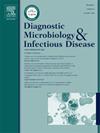Understanding the factors impacting dengue rapid diagnosis in Bangladesh
IF 2.1
4区 医学
Q3 INFECTIOUS DISEASES
Diagnostic microbiology and infectious disease
Pub Date : 2025-03-29
DOI:10.1016/j.diagmicrobio.2025.116827
引用次数: 0
Abstract
Background
Dengue affects over 70 % of the populations in tropical and subtropical regions, including Bangladesh, posing a significant health burden. The sensitivity of widely used rapid diagnostic tests (RDTs) varies due to factors like viral load, serotypes, secondary infections, and disease severity.
Aims
This study evaluated the diagnostic performance of RDTs compared to RT-PCR, identifying key factors affecting sensitivity.
Methods
The study at Dhaka Medical College (DMC) involved 683 suspected dengue cases. Blood samples and metadata were collected, and RDTs (NS1, IgG, IgM) were performed on-site. Samples were analyzed at icddr,b using RT-PCR for viral RNA detection and serotyping. Diagnostic performance was assessed using MedCalc, while metadata and sensitivity differences were analyzed with SPSS.
Results
We found that vomiting was the most common symptom, followed by, diarrhea, restlessness, and abdominal tenderness. RDT sensitivity was highest in cases with high viral loads, reaching 94 % within 1–3 days of symptom onset and 82 % beyond three days. Moderate viral loads showed sensitivities of 70 % for NS1+IgM and 84 % for NS1+IgM+IgG within three days, decreasing thereafter. Sensitivity was low in low viral load cases but improved after three days with IgG incorporation. DENV-3 and secondary infections showed higher false-negative rates.
Conclusion
The study emphasizes the importance of early testing in suspected dengue cases with symptoms like fever, vomiting, diarrhea, or abdominal tenderness, offering critical insights to enhance diagnostics, patient care, and disease control.
了解影响孟加拉国登革热快速诊断的因素
背景登革热影响着包括孟加拉国在内的热带和亚热带地区 70% 以上的人口,对健康造成了严重的负担。由于病毒载量、血清型、继发感染和疾病严重程度等因素的影响,广泛使用的快速诊断检测(RDT)的灵敏度各不相同。收集了血样和元数据,并在现场进行了 RDT(NS1、IgG、IgM)检测。样本在icddr,b使用RT-PCR进行病毒RNA检测和血清分型分析。结果我们发现,呕吐是最常见的症状,其次是腹泻、烦躁不安和腹部压痛。高病毒载量病例的 RDT 灵敏度最高,在症状出现后 1-3 天内达到 94%,三天后达到 82%。中度病毒载量病例在三天内对 NS1+IgM 的敏感度为 70%,对 NS1+IgM+IgG 的敏感度为 84%,此后敏感度下降。低病毒载量病例的灵敏度较低,但三天后加入 IgG 后灵敏度有所提高。该研究强调了对有发热、呕吐、腹泻或腹部触痛等症状的登革热疑似病例进行早期检测的重要性,为加强诊断、患者护理和疾病控制提供了重要的见解。
本文章由计算机程序翻译,如有差异,请以英文原文为准。
求助全文
约1分钟内获得全文
求助全文
来源期刊
CiteScore
5.30
自引率
3.40%
发文量
149
审稿时长
56 days
期刊介绍:
Diagnostic Microbiology and Infectious Disease keeps you informed of the latest developments in clinical microbiology and the diagnosis and treatment of infectious diseases. Packed with rigorously peer-reviewed articles and studies in bacteriology, immunology, immunoserology, infectious diseases, mycology, parasitology, and virology, the journal examines new procedures, unusual cases, controversial issues, and important new literature. Diagnostic Microbiology and Infectious Disease distinguished independent editorial board, consisting of experts from many medical specialties, ensures you extensive and authoritative coverage.

 求助内容:
求助内容: 应助结果提醒方式:
应助结果提醒方式:


